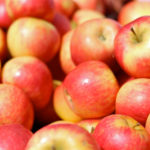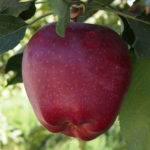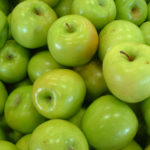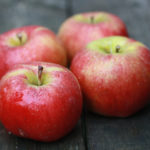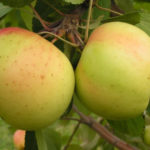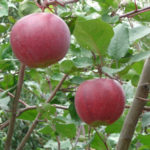Apple variety Phoenix Altai
Now it is hard to believe it, but at the beginning of the 20th century there were practically no apple orchards in Altai. But everything changed when a young specialist, breeder M.A. Lisavenko. And work began to boil, varieties of Siberian apple trees, resistant to adverse conditions, began to appear. But here's the problem, the locals reacted with suspicion to such a miracle. How, cultivated apple trees in Siberia? It can not be. Therefore, in the fall of 1950 in Barnaul, the first apple varieties bred by Lisavenko were selling very poorly. But the lucky ones, who believed the scientist and acquired seedlings, in a few years already could boast of their first apple harvests to their distrustful neighbors. This is how the scientist's dream came true, and the Siberian region began to fill with flowering apple orchards. As a legacy, the breeder left the gardeners varieties that he created himself, and those on which, after his departure, his colleagues and students continued to work. One of these is Phoenix Altai, selected in 1948 among seedlings from free pollination of Bellefleur Phoenix. Authors: M.A. Lisavenko, I.P. Kalinina, L.Yu. Zhebrovskaya, N.V. Ermakova. In 1974, the variety was included in the State Register of Breeding Achievements of Russia. Initially, the novelty was zoned in Altai, especially in the low mountains and mountainous areas. But after variety trials, it received admission throughout the West Siberian region (Altai Republic, Altai Territory, Kemerovo, Novosibirsk, Omsk, Tomsk, Tyumen regions). Applicant and originator - Federal State Budgetary Scientific Institution "Federal Altai Scientific Center of Agrobiotechnology". The variety is valued as a material for breeding. With the help of our hero, the Altynai apple tree and a large number of elite forms with scab resistance and high-quality fruits were bred at NIISS.
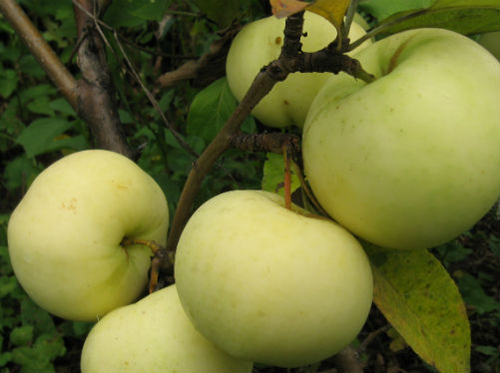
Description
The plant belongs to large semi-crops. The tree is of medium growth, but there is information that the maximum height can reach 8 meters. Annual growth is recorded at the level of 5 - 7 cm. A spherical crown of medium density is formed by a few skeletal branches that extend from the trunk at right angles. Mixed fruiting. The bulk of the crop is formed on ringlets and fruit twigs, which are formed in large quantities on the main branches. Shoots are thick, strong, with dark brown bark, pubescent. Leaves are green, large, ovoid, with a slightly elongated apex, arcuate base, crenate edges, surface with a matte sheen. The leaf blade of the apple tree is folded along the central vein in the form of a boat. The pubescent petiole extends from the shoot at a right angle, the stipules are small, needle-like or lanceolate.
The fruits of the variety are flat-rounded or rounded-flattened, sometimes with large, weakly pronounced ribbing. The funnel is of medium depth, wide, rusty in the form of a radiant mesh. The saucer is small, narrow, ribbed. Closed cup, regular size. The sub-cup tube is funnel-shaped, of medium size. The seed chambers are closed, the axial cavity is narrow. The peduncle is pubescent, of medium length and thickness. The skin is smooth, shiny, oily to the touch. The main color is light yellow; on the sunny side, the surface is decorated with a blurry light red blush. The fruits of the Phoenix Altai are below medium to medium in size. The mass of apples according to the State Register is 110 grams, the maximum is 135 grams. According to VNIISPK, the weight of the fruit is 72 - 134 grams. But for the conditions of Siberia, such dimensions are considered more than good. The pulp is white, fine-grained, juicy, with a pleasant aroma. The taste is very good, sweet and sour. Tasting score 4.3 points. 100 grams of pulp contains: pectin 4.15% on dry weight, total sugars 10.7% (7.2 - 16), titratable acids 0.97% (0.68 - 1.31), tannins 83 mg (46 - 116), ascorbic acid 16.7 mg (6.1 - 25.8), P-active compounds 123 mg (83 - 163).
Characteristics
- The apple tree begins to bear fruit in 4 - 5 years after planting with a one-year seedling. But in unfavorable conditions, fruiting can be delayed for another year;
- variety of winter ripening period. The harvest ripens in the first decade or mid-September. If the apples are overripe, then they may fall off, so it is not worth delaying the harvest;
- The culture cannot boast of regular fruiting, but still the productivity of the tree is high. In the city of Gorno-Altaysk for 19 years of cultivation, the average yield with a planting scheme of 6.0 mx 4.0 m was 11.6 t / ha. According to other sources, up to 23.0 tons are harvested from one hectare; from one tree can be removed from 30 to 50 kg of fruit;
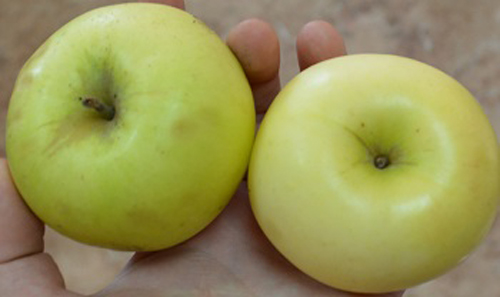
- With regard to winter hardiness, the State Register and VNIISPK note the insufficient ability of the Altai Phoenix to withstand unfavorable winter conditions in the Altai Territory. Winter temperatures that are comfortable for the plant should not exceed -35 ° C. In especially cold winters, the apple tree may freeze to a moderate degree. But at the same time, our hero has a surprisingly high recovery ability. In order to prevent freezing, experienced gardeners of the West Siberian region found a way out by forming the tree in the traditional northern way, that is, in the stanza form. It is easy to cover the creeping crown under a layer of snow or other covering material, so you can not worry about the safety of the main branches;
- the immunity of the variety is average. The State Register notes that the variety is slightly affected by scab. But other sources, including VNIISPK, on the contrary, indicate that there is a sensitivity to scab. It is especially evident during wet and cool summers. Therefore, preventive treatments of the garden must be carried out in accordance with the schedule. And in unfavorable periods, it is important to timely detect the onset of the apple tree disease in order to take measures to combat it as soon as possible;
- apples can be stored for a long time, about 4 months, without losing their presentation and taste;
- harvest can be used universally. First of all, apples are consumed in their natural form. But besides this, the harvest of the Altai Phoenix can be processed into many healthy and tasty products - jam, preserves, compote, baking stuffing, dried fruits. The high content of pectin in the pulp allows you to enjoy homemade marmalade or marshmallow.
Pollinators
Unfortunately, the variety will not be able to show high productivity without the right pollinators. To increase the yield and quality of fruits, blooming at the same time as our hero varieties Novosti Altai will help, Gornoaltaiskoe, Pepinka Altai and Altai Velvet.
Planting and leaving
The conditions of the admission region dictate the need to comply with some nuances when planting and growing an apple tree. Oddly enough, but experienced gardeners still recommend autumn planting, carried out 3 weeks before the onset of stable cold weather. Pick a place on a flat or slightly elevated, well-lit area. The soils are preferable loose, moisture-capacious and air-permeable, fertile. Loam meets such requirements, sandy loams are also suitable, although they will require more frequent watering and fertilization. On the north side, the Altai Phoenix sapling must be protected from the wind, so it is desirable that a fence, building or dense plantings are located in this part of the garden. But at the same time, you cannot plant a plant in a remote nook, without lightly blowing off the crown, the variety can easily become a target for fungal diseases.
Gardeners pay special attention to the formation of the crown. As a rule, most gardeners in unfavorable climates prefer to grow apple trees in stanza form. Formation begins the following spring after planting.The top is shortened by 15 cm, and the flexible trunk is bent parallel to the soil surface and fixed in this position with a metal hook or hairpin. The distance to the soil should be at least 40 cm. The shoots that have grown over the summer are also fixed in a creeping position; they must be fixed no later than August. Thus, the height of an adult tree rarely exceeds 50 cm, it will not be difficult to cover the plant, so it does not threaten to freeze.
Phoenix Altai is valued by Siberian gardeners for good harvests, sufficient large-fruited by the standards of Siberia and excellent taste. The fruits of our hero have high commercial and consumer qualities. Generally, the care of the culture is not difficult. But there are still some peculiarities, first of all they are connected with the formation. However, if there is no desire to tinker with the creeping crown, the apple tree can be formed in a sparse-tiered form. Small disadvantages of the variety are insufficiently high winter hardiness and low resistance to scab in wet years. But the correct agricultural technology is able to smooth out these shortcomings.
